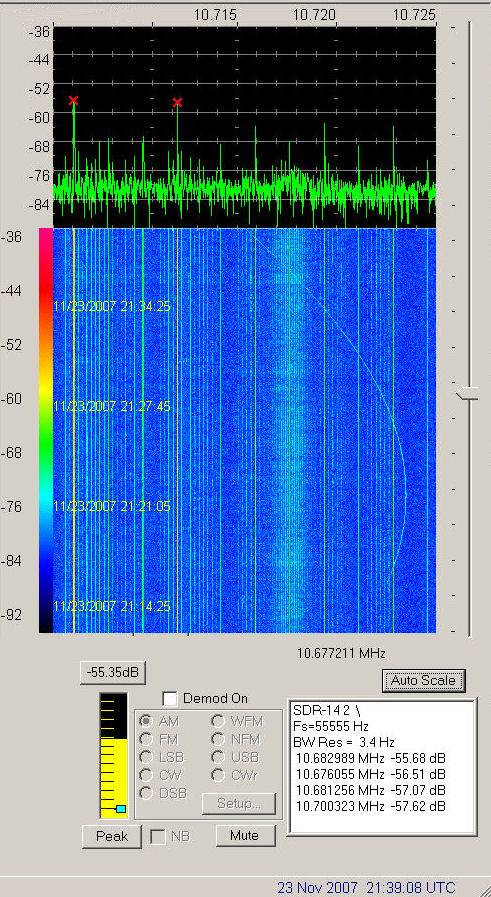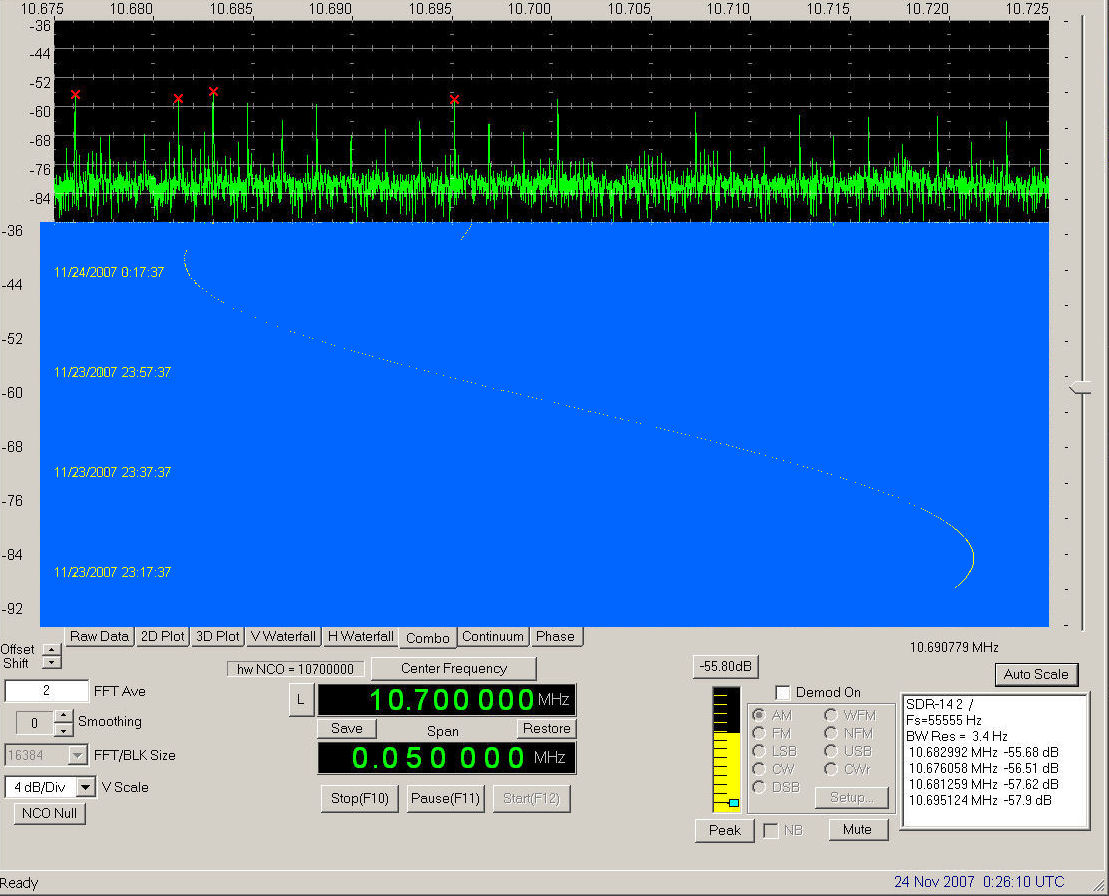Finally picking up Selene
in Stockholm
Sven Grahn

November 23, 2007 -
three passes across the visible face of the Moon
When I picked up my wife at the train
station tonight I noticed that the Moon was
very high in the sky and figured there was a chance to pick up the
japanese spacecraft Selene that is orbiting
the Moon. I turned on
the waterfall (see the article "Finally
on the air on S-band") at 2
sec/update at 50 kHz bandwidth (FFT bins 16384) and centered at
2263.602 MHz. At about 1917.50 UT a very weak, but definitely visible
carrier appeared on 2263.614 MHz. A few minutes after
acquisition-of-signal (AOS) the Doppler
shift reached a maximum and shortly thereafter the frequency jumped up
4 kHz and then again 8 kHz up. The ground station locked up on to
the receiver. There was Doppler minimum at about 2023 UT at
2263.587 MHz. a few minutes later (2027.30 UT) the frequency
jumped up 11 kHz and at 2029.30 UT there was loss-of-signal (LOS).
I guess this
whole reception period represented a pass across the lunar disk. The
signal was weak, but considering that my 3.5-turn helix points straight
up, I guess it was OK. The signal could only be seen on the waterfall,
not on the spectrum display.
So, I joined the select club that
have tracked Selene. Thanks to the Moon for climbing so high in the
sky.
On the next pass across the face of the Moon I certainly picked it up
again. his time the signals strength was much higher. The Moon looked
as if it was 65-70 degrees above the horizon. The pass lasted from
2115-2228.30 UT. The maximum frequency was 2263.625
MHz and the minimum was 2263.587 MHz. Just after that the frequency
suddenly jumped up 11 kHz and the the probe slipped around the edge of
the Moon as the signal disappeared. The figure on the right shows the
initial part of the pass. Here it is also evident how much spurious
signals and interference that is visible on the waterfall display. (By
the way: 10.700 MHz corresponds to 2263.602 MHz).
The Moon was
still high in
the sky so the next pass around the Moon came in loud and clear as well
at 2314-0026 UT. Just as before the frequency jumped up about 13 kHz just before LOS.
November 24, 2007 -
now it is routine!
The high elevation of
the Moon made it impossible to stay away from receiving Selene again
the following evening. The Selene signal appeared faithfully again and
the same behaviour with a frequency jump just before LOS was
repeated. At times the C/N was 10 dB, which is
amazing, but depedent on the 3.4 Hz bandwidth used. The reception times were:
1850-2004 UT
2045-2202.00 UT
2241-0000 UT
Estimating the orbital
period and altitude from observations
By analyzing these
reception times one can see that the probe came 27.8, 25.5, 30, 26.5,
33, 26 minutes earlier on the 24 th compared to the 23 rd . I think
the"outliers" should be eliminated. The average of the remaining
numbers is -26.45 minutes, which corresponds to 117.8 minutes orbital
period. This is equivalent to an average altude of 99.5 km, close to
the announced figure of 100 km. By simple trigonometry the time that
the probe is visible from eart on each orbit can be estimared. to be
71.3 minutes. The observed reception times are: 71.7, 73.5, 72, 74, 67,
69 minutes. I think the reception times that are much longer than 71.3
minutes are inaccurate because I estimated the times from
"eyeballing" the waterfall display.
The reason for the
frequency jumps - a hypothesis
Why does the
frequency suddenly jump just before loss-of-signal? The velocity
relative to earth when the probe disappears behind the moon is about
1.54 km/s. Of course, at the equator the circumferential speed is
about 0.45 km/s, but at 59 N and with the Moon at 70 degrees elevation,
let us disregard this effect for the moment. So, if the Selene
transmitter were not locked to an uplink the carrier would be shifted
downwards by 11.6 kHz. If the donwlink were locked to a fixed-frequency
uplink the frequency would be shifted downwards by another 10.7 kHz
(one has to take the turn-around ratio 240/221 into account), again
neglecting the effect of the earth's rotation. So, just before LOS the
uplink is turned off and the Selene transponder returns to its
free-running transmit frequency and the uplink downward shift
disappears. That is why the frequency jumps up by 10-13 kHz. I think
the fact that it is not alwyas abou + 11 kHz may be related to which
antenna is providing the uplink and where it s in relation to the Moon.
But why do we not see simular big jumps near AOS he observed frequency
jumps are much smaller, often just a few kHz- I tink that the uplink
transmit frequency is adjusted so that the downlink frequency does not
jump very uch. This will simplify receiver lock-on on the ground.
A complete Doppler
cycle during a pass across the Moon
In the waterfall picture
below I have edited out all the interference
(while they are still visible in the spectrum display) and hand -edited
every pixel where the carrier was visible by making it yellow. Whe
running the display this slowly (12 seconds between updates) and the
signla is varying very much close to the nise level, the display
catches the carrier rather seldom. So, overview and signal clarity do
not quite match when the signal is this weak. Anyway the 13 kHz
frequency jump just before loss-of-signal is clearly seen.



